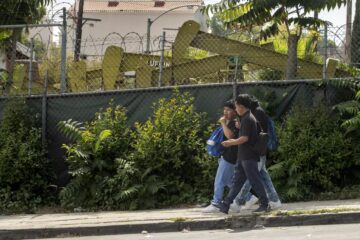Prime Site to Become Parkland
Soka University’s sale of its land in Santa Monica range for $35 million ends a long, bitter battle to save a mostly pristine swath of woodlands.
Source of this article – Los Angeles Times, April 17, 2005.
By Jason Felch, Times Staff Writer

FRAMING THE VIEW: The 588-acre Soka University site’s broad, grassy plain is ringed by oak-studded mountains.
Ending a 30-year quest, public officials announced Saturday the purchase of Soka University’s 588-acre swath of mostly pristine woodlands in the heart of the Santa Monica Mountains for use as parkland.
The $35-million deal closed escrow Friday, marking both a major environmental achievement and the last chapter in an often bitter legal battle that in recent years pitted the Buddhist university’s leadership against conservationists.
“We’re here to tell the earth, this land belongs to the people of California,” said Joseph Edmiston, executive director of the Santa Monica Mountains Conservancy, the largest of 11 funding sources that included federal, state and local agencies and local residents. “As Griffith Park is to the city of Los Angeles, this land is to the Santa Monica Mountains.”
Some of the land’s fire roads will be open to the public immediately, and hiking trails and other facilities are being planned. The 12-acre university campus will remain closed to the public for three years as Soka phases out of the site and park agencies consult with the public on its best uses.
The site’s oak-studded mountains cup a broad, grassy plain where five creeks converge. The campus of Soka University — a liberal arts school founded by Japanese Buddhists — lies in the heart of the property, near the intersection of Mulholland Highway and Las Virgenes Road, outside Calabasas.
The land was once the site of a large Chumash Indian settlement, the remains of which can still be seen. In the 1920s it belonged to razor blade magnate King C. Gillette, who never lived to see the razor blade-shaped swimming pool built there for him.
 It was identified as a top candidate for parkland in 1974, launching a conservation effort that would eventually reach the state Supreme Court.
It was identified as a top candidate for parkland in 1974, launching a conservation effort that would eventually reach the state Supreme Court.
That struggle ended amicably last year when the university announced its willingness to sell the land in a meeting with Los Angeles County Supervisor Zev Yaroslavsky, who some said Saturday was key to finalizing the complex deal.
It was a surprising turnaround for the university, which over a decade of threats and enticements, negotiations and legal wrangling had been unwilling to sell.
The university acquired the land in 1987 and invested more than $70 million to restore parts of the property left in disarray by its former occupants, the Church Universal and Triumphant. The sect’s leader, Elizabeth Clare “Guru Ma” Prophet, had bought the property in 1978 for $5.8 million and called it Camelot. But her followers led it slide into disrepair.
In 1990, Soka announced plans to expand its facilities, hoping to increase its student population from a few hundred to several thousand. Conservationists and local residents fought the proposal in repeated legal challenges.
In 1994, the Mountains Recreation and Conservation Authority, a local government agency that acquires parkland, used its power of eminent domain for the first time, and won the right to buy the property. But the extended legal battle left the authority without the resources to buy the land, and the effort failed.

PICTURE-PERFECT SETTING: Former Soka University student Kazu Kinoshita and his fiancee, Kaori Kinoshita, pose for a photograph on the road leading into the campus.
“We prevailed legally, but they prevailed strategically,” said Edmiston, who led the conservation effort for many years.
A compromise agreement between the parties was reached in 1996, only to be thrown out by a state appellate court in 2001. The California Supreme Court refused to hear Soka’s appeal of that ruling the same year.
With its efforts to expand effectively stopped, Soka opened a $220-million campus in Aliso Viejo in August 2001 and found itself free of the development controversy the school faced in Calabasas. The success of that campus, which will graduate its first undergraduate class in May, contributed to the decision to sell the Calabasas property, Soka officials said.
The sale “was a decision by our board to use these resources to help the Aliso Viejo campus,” said Wendy Harder, spokeswoman for Soka.
Since the agreement to sell was reached last year, Yaroslavsky and others worked for months to bring together a coalition of agencies and residents to find the money.
The Santa Monica Mountains Conservancy provided $10 million in funding, the California Department of Parks and Recreation provided $7.1 million, the California Coastal Conservancy contributed $5.5 million, the Wildlife Conservation Board provided $5 million and the National Park Service and the Santa Monica Bay Restoration Commission each gave $2.5 million. The remainder came from local governments and residents.
Of the 588 acres, about 406 will be controlled by the Mountain Recreation and Conservation Authority. The state parks department will get 102 acres and the Santa Monica Mountains National Recreation Area will own 80 acres. Officials said the parkland will be managed jointly by the three agencies.
Despite the challenges, officials said the acquisition of the Soka University land was a model for cooperative conservation efforts across the country.
“This is the gold standard of acquisitions,” Yaroslavsky said.


